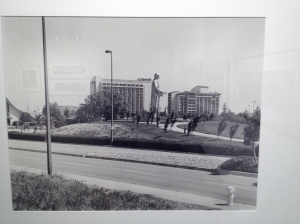I woke up on Saturday morning and decided to stop in at the Dickinson College Goodyear Gallery. Since I live in one of the Goodyear apartments, it was literally right out my back door. Within a minute of leaving my apartment, I was surrounded by the photography of Tom Fischer, a professor of photography at Savannah College of Art and Design. Fischer’s work has been shown in more than 60 exhibitions in galleries and museums in the U.S., Europe, and Asia—his most recent photography project is featured at the Goodyear Gallery.

The exhibition is called “Paradise | Paradox” and it features 20 black and white photographs presented on simple white backgrounds with sleek black frames. Some of the photos were presented parallel to others in order to contrast the two. Such as these two photos:

The controlled natural environment of the upper photo contrasts with the wild natural environment of the lower photo. Fischer deliberately places these photos together in order to draw the viewer’s attention to how human being have changed natural environments. In many ways, Fischer’s photographs criticize the effects of humanity on the natural world.

In the photo above entitled “Low Tide Candlestick Point,” tires and other trash scatter the beach which surrounds a body of water. The unnatural waste in the foreground of the photo draws the viewer’s attention, but mountains full of buildings and construction cranes in the background emphasize the pervasiveness of humanity’s effects on this environment.
Although Fischer’s exhibition explores humanity’s effects on natural environments, it is also interested in irony.


Both of these photographs explore the ironies of consumer culture from which not even death and religion can escape. In the upper photograph, an E-Z Motel sign is visible in the background of a tomb. Building a motel in such close proximity to the graveyard leads to this ironic and clashing image. It is hard to appreciate the peaceful resting place of the deceased when a motel sign is only a few meters away. In lower photograph, a statue of Jesus stands on a hill in front of a Marriott hotel. In both photos the images associated with spirituality clash with images associated with consumer culture.
Fischer’s photographs effectively communicate both the ironies of consumer culture and humanity’s negative effects on the environment. These two themes work well together and often overlap. His exhibition in the Goodyear Gallery unfortunately ended on November 8th, but you can look forward to the “Senior Studio Art Seminar: Works in Progress” exhibition which begins November 18th. (The Goodyear Gallery’s hours are: Tuesday-Friday 3-5pm and Saturday 2-5pm)
I love your visual analysis of Fischer’s photography, James. I think you express the point of view of the photos beautifully. His use of black and white is very arresting; nowadays I think we take the power of its simplicity for granted. I wish I had been able to see the exhibition in person! I’ll definitely be on the lookout for the Senior Studio Art Seminar exhibition. It’s great that we live so close to the art gallery!
LikeLike
Even though I also live in Goodyear, if it wasn’t for your blog and the fact that my roommate works in the gallery, I feel like I wouldn’t even know that this gallery existed. It’s a shame; I feel like art exhibits on campus, especially in the Goodyear Gallery, are not very well publicized, even though they feature such incredible work. Whenever I visit my roommate there at work, there are always only around five to seven names at the most signed into the visitor book. Unfortunately, I wasn’t able to make it down to see Fischer’s work, but I have been to previous exhibitions there, and they’re incredible. I love that you’re not only calling attention to Fischer’s work, but also to the Goodyear Gallery. I will definitely continue to visit it in the future!
LikeLike